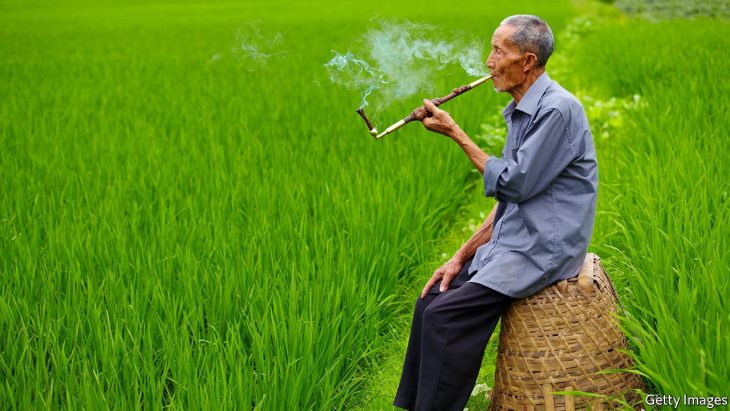Despite huge improvements since Mao’s dire day, farming in China is still woefully inefficient
COMMUNIST countries have always liked model workers. Zhang Xinsheng is China’s latest farmer to be anointed. He is no gnarled son of the soil but the owner of four companies and a farm where vegetables are grown under plastic sheets. In 2012, when he set up his agricultural venture in the central province of Henan, it took Mr Zhang six months to amass 53 hectares (130 acres) by persuading villagers to lease their plots of land. In 2017 he assembled another 47 hectares in half that time—thanks, he told a local newspaper, to rural land reforms. He plans to triple his farm’s size and turn the village, Luodian, from a poor grower of grain into a specialist producer of vegetables.
Mr Zhang’s story exemplifies a profound transformation in Chinese agriculture that has been unfolding since the 1980s. It involves a shift away from a preoccupation with producing enough grain for the country’s needs, towards boosting rural incomes by encouraging farmers to grow more profitable crops and use scarce arable land more efficiently. The government is eager to speed up this change. It is not proving easy.
China grows enough staples to feed its 1.4bn people. The rice crop of 2017 was a record; output of grains has risen more than 40% since 2003. Cereal yields per hectare are higher than Canada’s. This is a stunning success for a country where millions starved in Mao’s Great Leap Forward, and has freed millions from the rural grind to join China’s industrial revolution.
But these feats on the farm have come at a cost. China uses twice as much fertiliser and pesticide per hectare as the world average, contributing to catastrophic levels of soil pollution. In northern China, the country’s bread basket, wheat farmers use far more water than this bone-dry region can afford or replace. And because food quantity has taken priority over quality, there have been huge food scares.
The rural economy remains backward. A recent agricultural census showed there were 314m people employed in farming in 2016. That is 40% of China’s workforce. Yet agriculture accounts for less than 9% of GDP, which means that rural labour is still extremely unproductive.
Moreover, the exodus from the land has slowed, implying that the problem of underemployment is not going away. The farming population fell by 100m in the decade to 2006 but only 28m in the following ten years. Most of those still tilling the fields are old and ill-schooled. In 2016 more than half of all farmers were over 55 and almost half had only a primary education.
Since all successful Chinese revolutions have begun in the countryside, the Communist Party is alarmed. In October China’s president, Xi Jinping (whose PhD thesis was on “rural marketisation”), unveiled a “revitalisation strategy” for the countryside that would “prioritise agriculture”. Though vague, the strategy signals a renewed emphasis on reforming two vital aspects of farming.
First, prices. This year, for the first time, the government will lower the guaranteed sum that it pays farmers for wheat. Minimum prices for maize and rapeseed were scrapped in 2015. This shift should encourage greater efficiency. There will be less incentive for farmers to grow grain in places where it is costly to do so, such as in the north where water is scarce. The government will still help them, however, by boosting farm subsidies.
The legacy of Mao
Just as important are changes to land tenure, aimed at encouraging the growth of larger farms and new investment in them. Almost all farmland in China is owned by village collectives. In the 1980s households were given the right to use a portion of the land for themselves. Since 2008 they have had the right to lease these rights to others (this is how Mr Zhang put together his vegetable operation). But there has been a bottleneck: a lack of legal clarity about the boundaries of farmers’ fields. This has hampered the growth of larger farms. The recent census found only 4m “scaled-up farms”, 2% of the total. Almost 30% of them were in livestock or fish farming, compared with only 4% for all farms. This reflects the continued importance of ideology: animals are regarded as private property but land as collective. This impedes the growth of large, privately owned, crop-growing ventures. Mao hated rural landlords (millions of them may have died in his purges). His thinking endures among bureaucrats.
In 2018 officials will complete work on handing out certificates to farmers with details of their plot boundaries. This should spur consolidation. Even so, it will remain hard for people like Mr Zhang to borrow money to rent land, since land-use rights cannot be used as collateral. Pilot programmes allowing this are under way, but there is no nationwide scheme. And there is no hint that China is willing to let farmers own land in order to capture the benefit of rising land prices—a common route to wealth for farmers in other countries but still anathema to the party’s ideologues. Until that happens, the growth of large farms is likely to remain slow.
Source: The Economist



